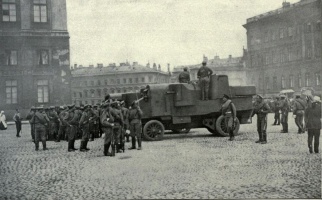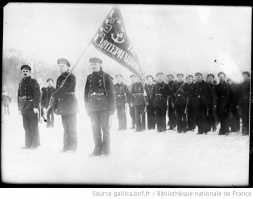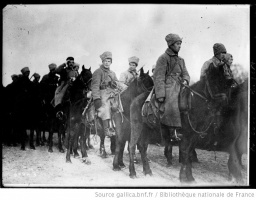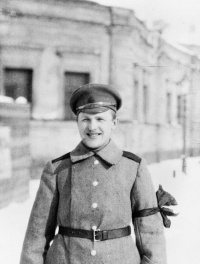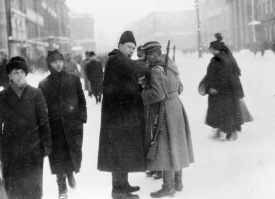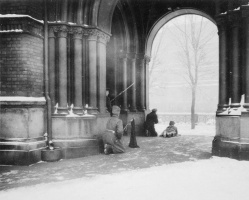Towards a Regular Army↑
The disintegration of the Imperial Army opened the way for the Bolshevik takeover of power. Soldiers refusing to recognise the authority of their officers had deserted, mutinied, and formed committees to demand radical reforms and an end to the war. After the February Revolution in 1917, the officers blamed the Provisional Government for this collapse and did not intervene when Vladimir Lenin's (1870-1924) party overthrew it in October 1917. Many soldiers had reason to believe that the Bolsheviks would support their calls for demobilisation. However, the new government soon found itself facing internal and external threats for which it required an armed force to defend itself.
The Bolsheviks distrusted regular standing armies, which they associated with the social privilege and repression of the old regime. As socialists, they preferred a citizens' militia made up of class-conscious proletarians. Therefore, in January 1918, the Bolsheviks first sought to build a voluntary army using the Red Guards — the politicised units of armed workers — as a core. Recruitment was to be based on political loyalty and social class. However, only 20,000 volunteers answered the call up instead of the 300,000 hoped for. When hostilities with Germany resumed following the breakdown of the Brest-Litovsk peace talks, the new force was defeated at Narva in February 1918, forcing the Soviet government to sign a humiliating peace treaty.
Following this failure, Leon Trotsky (1879-1940), the newly appointed Commissar for War, oversaw a series of measures to create a regular army in the spring of 1918. These efforts continued following the outbreak of the Civil War. Trotsky banned the election of officers, although in some units it continued until 1920. The government began creating a commanding cadre by using former tsarist officers as military specialists (voenspetsy) and setting up a training scheme for workers and poor peasants to become Red commanders. Military tribunals and uniforms returned to improve military discipline; general and compulsory military service was also reinstated. In June 1918, the Bolsheviks announced conscription in many areas of central Russia. They preferred, initially, to mobilise workers rather than peasants. However, the government came to realise that in order to field an army large enough to defeat the Whites, it was essential to expand the social composition of the Red Army. After the Eighth Party Congress of March 1919, it extended conscription to primarily peasant regions. By the end of the Civil War, 75 percent of the Red Army was of peasant origins.
Controversies and Control↑
These were controversial policies. Many Bolsheviks, still preferring a class-based militia, resisted them throughout the Civil War. At the Eighth Party Congress, the Military Opposition attacked mass conscription for diluting the proletarian character of the Red Army. While the Civil War raged, the supporters of a regular army generally won the argument, but victory changed this. In 1921, the Tenth Party Congress approved a compromise combining a large territorial militia with a small regular army. Theoretically, the latter would disband when the international and domestic conditions permitted it.
The debate over the regular army also influenced measures to ensure party control over the army and raise the revolutionary consciousness of its rank-and-file. The position of commissar was introduced to ensure the political loyalty of commanders and, in particular, of military specialists and to strengthen their authority over the troops. Orders from commanders required the countersignature of a commissar. The Bolsheviks mobilised Communist party members into the army to bolster its resolve. They created special-assignment units (chony), largely autonomous elite units of local party workers, which often operated alongside secret police (Cheka) troops. A Political Administration of the Red Army (PUR) was founded to supervise the commissars and coordinate the party work in the army. Political officers and party cells promulgated Communism among the Red Army men to win their loyalty. To this end, they also sought to improve the literacy of the generally uneducated peasant soldiers. For much of the Civil War, the political institutions had to combat partizanshchina — independent local forces within the Red Army that refused to recognise central control — by removing or shooting the partisans' commanders and breaking up their units.
The sheer variety of forces mobilised, each with conflicting ideas of their role and importance, ensured clashes among them. Indeed, a bewildering array of civil and military institutions emerged to direct and oversee the Red Army, in part because of the Bolsheviks' fear that a Russian Bonaparte might challenge their authority, in part as a result of the need to find makeshift solutions at short notice. Some traced their authority to the governmental apparatus of the Soviet of People's Commissars, others to the All-Russian Central Executive Committee of the Congress of Soviets and yet others to the Politburo of the Russian Communist Party.
The move towards a mass army in 1919 created enormous supply problems. In a vicious circle, the lack of supplies led to large-scale desertion and the need for further conscription, which in turn further strained supplies. Punitive measures alone proved ineffective. The Bolsheviks employed amnesties and introduced welfare support for the families of Red Army men to tackle the problem. There was particular suspicion towards the voenspetsy. These deserted no more often than did other Red commanders. However, the impact of their disloyalty was often great as they included graduates of the General Staff Academy in important positions. Some even managed to set up secret organisations within the Red Army to help the Whites.
The Red Army and the Soviet State↑
Despite these difficulties, the Bolsheviks forged the Red Army into a tool capable of maintaining its power in Russia and keeping most of the former Empire's territory under its control. At its height in October 1920, it was, on paper, 5.5 million strong, although only about 700,000 of these were active fighters. Certainly, the failings of its opponents, who, indeed, faced many of the same problems, helped it triumph. However, the creation of the Red Army also demonstrated the Bolsheviks' superior state-building abilities. Combatting desertion, for example, required the establishment of a documentary regime to determine who had been called up. The support given to the families of Red Army men redefined the relationship between the soldier and the state, transforming military service into a contract between the two.
Thus, the creation of the Red Army in the midst of the Civil War had far-reaching consequences for the emergent Soviet state. It also had fateful repercussions for the ruling party and the army itself, militarising the former and subjecting the latter to extensive party control. In the party, military service became a central marker of political loyalty, a wartime ethos of sacrifice and obedience emerged, and even the language of politics acquired a distinctively military tone. For its part, the Red Army's subordination to the party and the diverse backgrounds of its commanders deprived its officer corps of autonomy, cohesion and identity. These weaknesses increased its vulnerability during the Stalinist purges of the army and were evident in the military defeats suffered by the Soviet Union at the beginning of the Second World War.
Christopher Gilley, Universität Hamburg
Section Editors: Yulia Khmelevskaya; Katja Bruisch; Olga Nikonova; Oxana Sergeevna Nagornaja
Selected Bibliography
- Benvenuti, Franceso: The Bolsheviks and the Red Army, 1918-1922, Cambridge; New York 1988: Cambridge University Press.
- Figes, Orlando: The Red Army and mass mobilisation during the Russian Civil War 1918–1920, in: Past & present 129, 1990, pp. 168–211.
- Hagen, Mark von: Soldiers in the proletarian dictatorship. The Red Army and the Soviet socialist state, 1917-1930, Ithaca 1990: Cornell University Press.
- Reese, Roger R.: Red commanders. A social history of the Soviet Army officer corps, 1918-1991, Lawrence 2005: University Press of Kansas.
- Sanborn, Joshua A.: Drafting the Russian nation. Military conscription, total war, and mass politics, 1905-1925, DeKalb 2003: Northern Illinois University Press.





